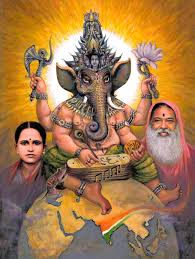This subject is explained in great detail in the Shaiva and Vishnava agamas (books on temple architecture). Stated briefly, the theme behind temple construction is:
Devo devālaya prokto jīvo dehah sanātanah Tyajedajnāna nirmālyam soham bhāvena pūjayet
The human body itself is the temple. The individual soul within is the diety. Ignorance is the dirt which accumulates everyday in a temple. When ignorance is removed it will be possible to realize the supreme consciousness reflecting within us. This is ‘Soham’ experience. This is the real worship.
It is to remind people of this fact that several schools of temple architecture were founded in ancient India. Though one might find many differences between temple architecture of North and South India, there are some striking similarities too. Also, the temple architecture of South India attaches much importance to the element of beauty; the fundamental principle is never forgotten or overlooked.
Irrespective of the school of architecture, every temple will have a sanctum sanctorum as well as a shrine (shikhara). The sanctum sanctorum (garbha gudi) is symbolic of the heart while the shrine symbolizes the head.
Yoga tradition says that the heart is the seat of the light called Prana. The shrine is constructed directly above the idol. It consists of a pot shaped structure. The surface underneath the pot is called kapala. Although the Prana has its seat in the heart, its activity potential lies in the head. Therefore at the time of consecrating a temple equal importance is given to installation of idol and installation of shrine. In fact a special ceremony called Kumbhabhisheka (abhisheka to the shrine) forms an integral part of temple consecration.
According to Agama shastra, not only the idol but the entire temple symbolizes the Almighty. Therefore special kumbhabhisheka is performed every 12 years. Because the shrine has much spiritual significance, it is kept at the topmost point in the temple. Just like the transmitting centre, it needs to be placed at a good height in order to transmit vibrations of peace and harmony.
Each and every part of the human body is represented in a temple. It is Avast subject in itself. In the human body, after the heart and the head, the spinal column occupies an important place as far as energy transmission is concerned. It not only keeps the body upright but is also a highway for the kundalini power. the tall pillar erected in front of the temple signifies this spinal column,
When the kundalini is kindled and finds its way to the top of the shrine, the blissful state results. To symbolize this, small bells are tied at the top of the pillar. Although the vertebral column ends near the neck, the spinal cord continues up to the Sahasrara chakra located at the top of the head. Therefore the pillar in front of the temple matches the height of the temple itself.
Because the spinal column is so important, the southern schools of architecture attach more importance to the pillar. Apart from this there are many more interesting facts pertaining to temple architecture.
(Bhaktimala June 1997)
